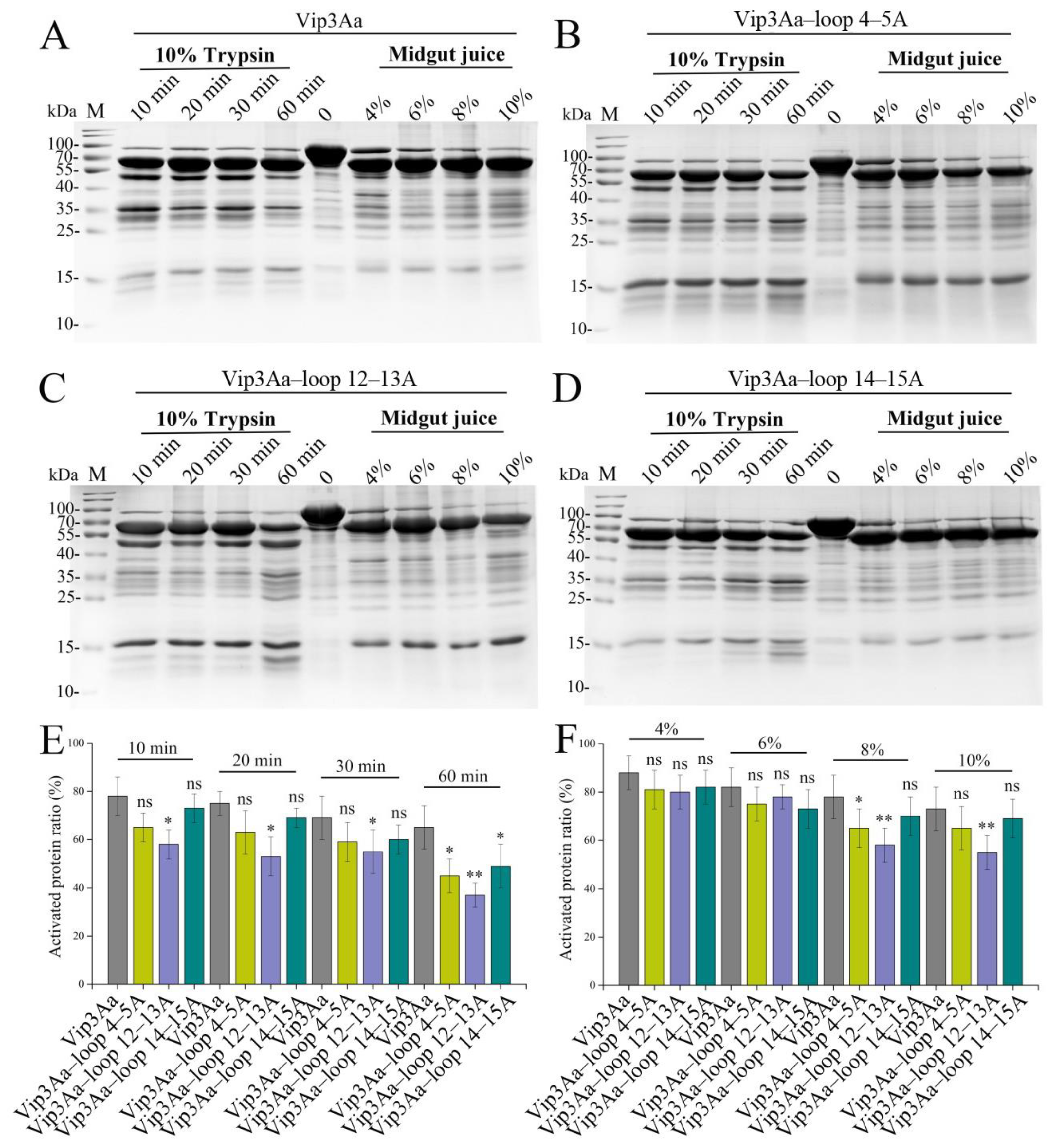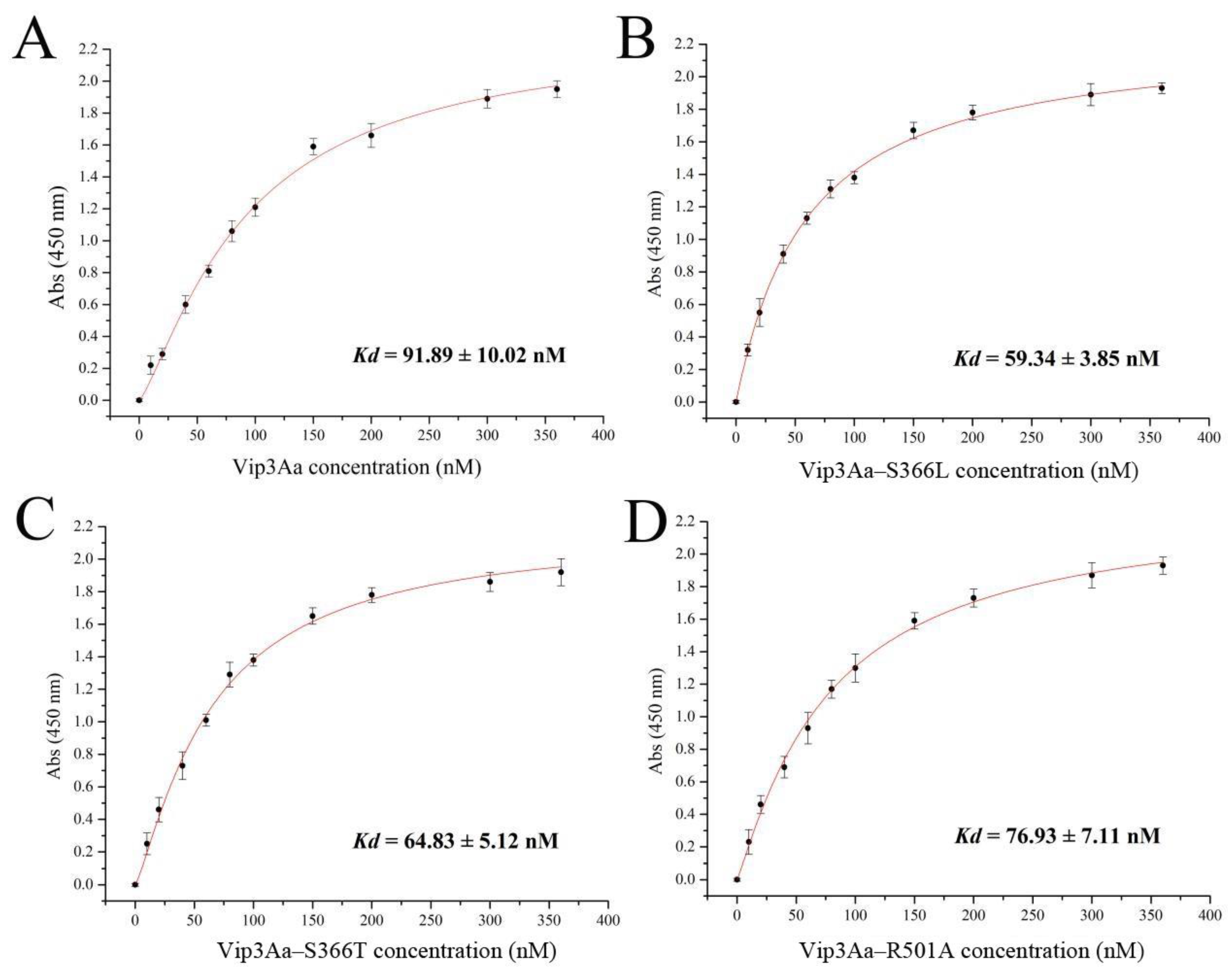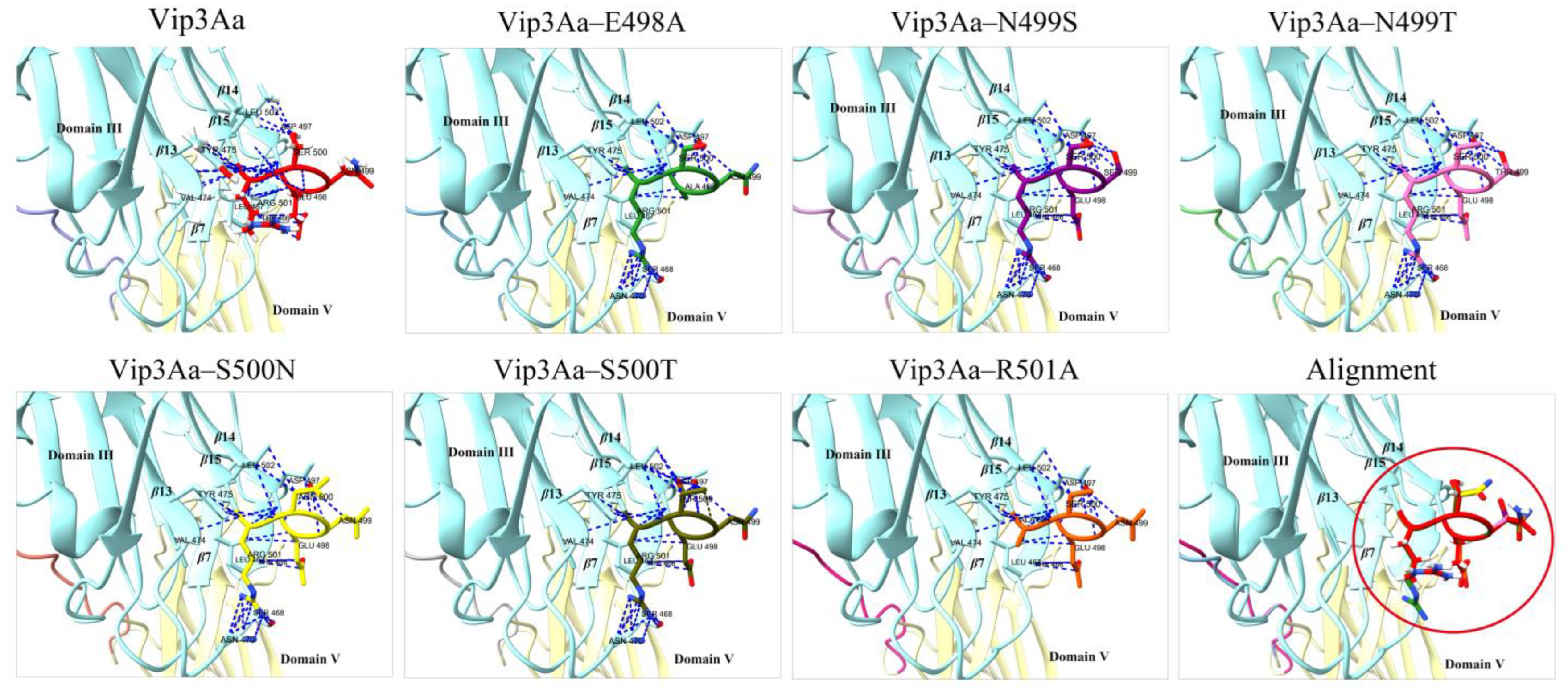Domain III β4–β5 Loop and β14–β15 Loop of Bacillus thuringiensis Vip3Aa Are Involved in Receptor Binding and Toxicity
Abstract
:1. Introduction
2. Results
2.1. Substituting the Sequence of the Loop in Domain III Reduces the Insecticidal Activity of Vip3Aa
2.2. Substituting the Sequence of the Loop in Domain III Affects the Stability of Vip3Aa
2.3. Substituting the Sequence of the Loop in Domain III Affects the Binding of Vip3Aa to S. frugiperda BBMVs
2.4. Selective Modification of the Loops in Domain III Contributes to the Insecticidal Activity of Vip3Aa
2.5. Toxicity–Enhanced Vip3Aa Mutants Bind More Strongly to S. frugiperda BBMVs
2.6. Three–Dimensional Structural Analysis of Vip3Aa Mutants
3. Discussion
4. Conclusions
5. Materials and Methods
5.1. Plasmid Construction
5.2. Protein Expression and Purification
5.3. Bioassay
5.4. Proteolysis Assay
5.5. ELISA Binding Assays
5.6. Vip3Aa or Mutant Subcellular Localization in Sf9 Cells
5.7. Protein Structure Modeling and Analysis
5.8. Statistical Analysis
Supplementary Materials
Author Contributions
Funding
Institutional Review Board Statement
Informed Consent Statement
Data Availability Statement
Acknowledgments
Conflicts of Interest
References
- Tay, W.T.; Meagher, R.L., Jr.; Czepak, C.; Groot, A.T. Spodoptera frugiperda: Ecology, Evolution, and Management Options of an Invasive Species. Annu. Rev. Entomol. 2023, 68, 299–317. [Google Scholar] [CrossRef] [PubMed]
- Li, G.; Feng, H.; Ji, T.; Huang, J.; Tian, C. What type of Bt corn is suitable for a region with diverse lepidopteran pests: A laboratory evaluation. GM Crops Food 2021, 12, 115–124. [Google Scholar] [CrossRef] [PubMed]
- Badran, A.H.; Guzov, V.M.; Huai, Q.; Kemp, M.M.; Vishwanath, P.; Kain, W.; Nance, A.M.; Evdokimov, A.; Moshiri, F.; Turner, K.H.; et al. Continuous evolution of Bacillus thuringiensis toxins overcomes insect resistance. Nature 2016, 533, 58–63. [Google Scholar] [CrossRef] [PubMed]
- Crickmore, N.; Berry, C.; Panneerselvam, S.; Mishra, R.; Connor, T.R.; Bonning, B.C. A structure–based nomenclature for Bacillus thuringiensis and other bacteria–derived pesticidal proteins. J. Invertebr. Pathol. 2021, 186, 107438. [Google Scholar] [CrossRef] [PubMed]
- Chakroun, M.; Banyuls, N.; Bel, Y.; Escriche, B.; Ferré, J. Bacterial Vegetative Insecticidal Proteins (Vip) from Entomopathogenic Bacteria. Microbiol. Mol. Biol. Rev. 2016, 80, 329–350. [Google Scholar] [CrossRef] [PubMed]
- Bel, Y.; Banyuls, N.; Chakroun, M.; Escriche, B.; Ferré, J. Insights into the Structure of the Vip3Aa Insecticidal Protein by Protease Digestion Analysis. Toxins 2017, 9, 131. [Google Scholar] [CrossRef] [PubMed]
- Núñez–Ramírez, R.; Huesa, J.; Bel, Y.; Ferré, J.; Casino, P.; Arias–Palomo, E. Molecular architecture and activation of the insecticidal protein Vip3Aa from Bacillus thuringiensis. Nat. Commun. 2020, 11, 3974. [Google Scholar] [CrossRef]
- Quan, Y.; Ferré, J. Structural Domains of the Bacillus thuringiensis Vip3Af Protein Unraveled by Tryptic Digestion of Alanine Mutants. Toxins 2019, 11, 368. [Google Scholar] [CrossRef]
- Byrne, M.J.; Iadanza, M.G.; Perez, M.A.; Maskell, D.P.; George, R.M.; Hesketh, E.L.; Beales, P.A.; Zack, M.D.; Berry, C.; Thompson, R.F. Cryo–EM structures of an insecticidal Bt toxin reveal its mechanism of action on the membrane. Nat. Commun. 2021, 12, 2791. [Google Scholar] [CrossRef]
- Jiang, K.; Chen, Z.; Zang, Y.; Shi, Y.; Shang, C.; Jiao, X.; Cai, J.; Gao, X. Functional characterization of Vip3Aa from Bacillus thuringiensis reveals the contributions of specific domains to its insecticidal activity. J. Biol. Chem. 2023, 299, 103000. [Google Scholar] [CrossRef]
- Quan, Y.; Lázaro–Berenguer, M.; Hernández–Martínez, P.; Ferré, J. Critical Domains in the Specific Binding of Radiolabeled Vip3Af Insecticidal Protein to Brush Border Membrane Vesicles from Spodoptera spp. and Cultured Insect Cells. Appl. Env. Microbiol. 2021, 87, e0178721. [Google Scholar] [CrossRef] [PubMed]
- Lázaro–Berenguer, M.; Paredes–Martínez, F.; Bel, Y.; Núñez–Ramírez, R.; Arias–Palomo, E.; Casino, P.; Ferré, J. Structural and functional role of Domain I for the insecticidal activity of the Vip3Aa protein from Bacillus thuringiensis. Microb. Biotechnol. 2022, 15, 2607–2618. [Google Scholar] [CrossRef] [PubMed]
- Jiang, K.; Chen, Z.; Shi, Y.; Zang, Y.; Shang, C.; Huang, X.; Zang, J.; Bai, Z.; Jiao, X.; Cai, J.; et al. A strategy to enhance the insecticidal potency of Vip3Aa by introducing additional cleavage sites to increase its proteolytic activation efficiency. Eng. Microbiol. 2023, 3, 100083. [Google Scholar] [CrossRef]
- Li, J.D.; Carroll, J.; Ellar, D.J. Crystal structure of insecticidal delta–endotoxin from Bacillus thuringiensis at 2.5 A resolution. Nature 1991, 353, 815–821. [Google Scholar] [CrossRef] [PubMed]
- Shao, E.; Lin, L.; Chen, C.; Chen, H.; Zhuang, H.; Wu, S.; Sha, L.; Guan, X.; Huang, Z. Loop replacements with gut–binding peptides in Cry1Ab domain II enhanced toxicity against the brown planthopper, Nilaparvata lugens (Stål). Sci. Rep. 2016, 6, 20106. [Google Scholar] [CrossRef] [PubMed]
- Pacheco, S.; Gómez, I.; Arenas, I.; Saab–Rincon, G.; Rodríguez–Almazán, C.; Gill, S.S.; Bravo, A.; Soberón, M. Domain II loop 3 of Bacillus thuringiensis Cry1Ab toxin is involved in a “ping pong” binding mechanism with Manduca sexta aminopeptidase–N and cadherin receptors. J. Biol. Chem. 2009, 284, 32750–32757. [Google Scholar] [CrossRef]
- Liu, J.G.; Yang, A.Z.; Shen, X.H.; Hua, B.G.; Shi, G.L. Specific binding of activated Vip3Aa10 to Helicoverpa armigera brush border membrane vesicles results in pore formation. J. Invertebr. Pathol. 2011, 108, 92–97. [Google Scholar] [CrossRef]
- Chakroun, M.; Ferré, J. In vivo and in vitro binding of Vip3Aa to Spodoptera frugiperda midgut and characterization of binding sites by (125)I radiolabeling. Appl. Env. Microbiol. 2014, 80, 6258–6265. [Google Scholar] [CrossRef]
- Jiang, K.; Hou, X.Y.; Tan, T.T.; Cao, Z.L.; Mei, S.Q.; Yan, B.; Chang, J.; Han, L.; Zhao, D.; Cai, J. Scavenger receptor–C acts as a receptor for Bacillus thuringiensis vegetative insecticidal protein Vip3Aa and mediates the internalization of Vip3Aa via endocytosis. PLoS Pathog. 2018, 14, e1007347. [Google Scholar] [CrossRef]
- Liu, M.; Liu, R.; Luo, G.; Li, H.; Gao, J. Effects of Site–Mutations Within the 22 kDa No–Core Fragment of the Vip3Aa11 Insecticidal Toxin of Bacillus thuringiensis. Curr. Microbiol. 2017, 74, 655–659. [Google Scholar] [CrossRef]
- Palma, L.; Scott, D.J.; Harris, G.; Din, S.U.; Williams, T.L.; Roberts, O.J.; Young, M.T.; Caballero, P.; Berry, C. The Vip3Ag4 Insecticidal Protoxin from Bacillus thuringiensis Adopts A Tetrameric Configuration That Is Maintained on Proteolysis. Toxins 2017, 9, 165. [Google Scholar] [CrossRef] [PubMed]
- Gomez, I.; Miranda–Rios, J.; Rudiño–Piñera, E.; Oltean, D.I.; Gill, S.S.; Bravo, A.; Soberón, M. Hydropathic complementarity determines interaction of epitope (869)HITDTNNK(876) in Manduca sexta Bt–R(1) receptor with loop 2 of domain II of Bacillus thuringiensis Cry1A toxins. J. Biol. Chem. 2002, 277, 30137–30143. [Google Scholar] [CrossRef] [PubMed]
- Adegawa, S.; Nakama, Y.; Endo, H.; Shinkawa, N.; Kikuta, S.; Sato, R. The domain II loops of Bacillus thuringiensis Cry1Aa form an overlapping interaction site for two Bombyx mori larvae functional receptors, ABC transporter C2 and cadherin–like receptor. Biochim. Biophys. Acta Proteins Proteom. 2017, 1865, 220–231. [Google Scholar] [CrossRef] [PubMed]
- Gómez, I.; Dean, D.H.; Bravo, A.; Soberón, M. Molecular basis for Bacillus thuringiensis Cry1Ab toxin specificity: Two structural determinants in the Manduca sexta Bt–R1 receptor interact with loops alpha–8 and 2 in domain II of Cy1Ab toxin. Biochemistry 2003, 42, 10482–10489. [Google Scholar] [CrossRef] [PubMed]
- Lee, M.K.; Walters, F.S.; Hart, H.; Palekar, N.; Chen, J.S. The mode of action of the Bacillus thuringiensis vegetative insecticidal protein Vip3A differs from that of Cry1Ab delta–endotoxin. Appl. Env. Microbiol. 2003, 69, 4648–4657. [Google Scholar] [CrossRef] [PubMed]
- Banyuls, N.; Quan, Y.; González–Martínez, R.M.; Hernández–Martínez, P.; Ferré, J. Effect of substitutions of key residues on the stability and the insecticidal activity of Vip3Af from Bacillus thuringiensis. J. Invertebr. Pathol. 2021, 186, 107439. [Google Scholar] [CrossRef] [PubMed]
- Yang, X.; Wang, Z.; Geng, L.; Chi, B.; Liu, R.; Li, H.; Gao, J.; Zhang, J. Vip3Aa domain IV and V mutants confer higher insecticidal activity against Spodoptera frugiperda and Helicoverpa armigera. Pest. Manag. Sci. 2022, 78, 2324–2331. [Google Scholar] [CrossRef]
- Hou, X.; Han, L.; An, B.; Zhang, Y.; Cao, Z.; Zhan, Y.; Cai, X.; Yan, B.; Cai, J. Mitochondria and Lysosomes Participate in Vip3Aa–Induced Spodoptera frugiperda Sf9 Cell Apoptosis. Toxins 2020, 12, 116. [Google Scholar] [CrossRef]
- Chakroun, M.; Bel, Y.; Caccia, S.; Abdelkefi–Mesrati, L.; Escriche, B.; Ferré, J. Susceptibility of Spodoptera frugiperda and S. exigua to Bacillus thuringiensis Vip3Aa insecticidal protein. J. Invertebr. Pathol. 2012, 110, 334–339. [Google Scholar] [CrossRef]
- Wolfersberger, M.G. Preparation and partial characterization of amino acid transporting brush border membrane vesicles from the larval midgut of the gypsy moth (Lymantria dispar). Arch. Insect Biochem. Physiol. 1993, 24, 139–147. [Google Scholar] [CrossRef]
- Kelley, L.A.; Sternberg, M.J. Protein structure prediction on the Web: A case study using the Phyre server. Nat. Protoc. 2009, 4, 363–371. [Google Scholar] [CrossRef]
- Goddard, T.D.; Huang, C.C.; Meng, E.C.; Pettersen, E.F.; Couch, G.S.; Morris, J.H.; Ferrin, T.E. UCSF ChimeraX: Meeting modern challenges in visualization and analysis. Protein Sci. 2018, 27, 14–25. [Google Scholar] [CrossRef]







| Protein | Mutation Description | LC50 (ng/g) (95% Fiducial Limits) | Slope ± SE | χ2 | DF |
|---|---|---|---|---|---|
| Vip3Aa | Wild type, no mutation | 251 (226–307) | 2.42 ± 0.15 | 8.97 | 5 |
| Vip3Aa–loop 4–5A | Mutation of residues 364–DSI–368 to 364–AAA–368 | 594 (506–713) | 1.56 ± 0.12 | 0.38 | 5 |
| Vip3Aa–loop12–13A | Mutation of residues 467–SANDDG–474 to 467–AAAAAA–474 | 375 (330–427) | 2.00 ± 0.13 | 1.55 | 5 |
| Vip3Aa–loop14–15A | Mutation of residues 497–ENSR–502 to 497–AAAA–502 | 970 (805–1219) | 1.59 ± 0.13 | 1.58 | 5 |
| Protein | Position | LC50 (ng/g) (95% Fiducial Limits) |
|---|---|---|
| Vip3Aa | - | 251 (226–307) |
| Vip3Aa–N470K | β12–β13 loop | 123 (107–141) |
| Vip3Aa–S366T/R501A | β4–β5 loop and β14–β15 loop | 145 (122–168) |
| Vip3Aa–S366L/R501A | 128 (104–172) | |
| Vip3Aa–S366T/N470K | β4–β5 loop and β12–β13 loop | 68 (51–86) |
| Vip3Aa–S366L/N470K | 56 (39–77) | |
| Vip3Aa–N470K/R501A | β12–β13 loop and β14–β15 loop | 113 (106–131) |
| Vip3Aa–S366T/N470K/R501A | β4–β5 loop, β12–β13 loop and β14–β15 loop | 108 (92–122) |
| Vip3Aa–S366L/N470K/R501A | 106 (86–125) |
Disclaimer/Publisher’s Note: The statements, opinions and data contained in all publications are solely those of the individual author(s) and contributor(s) and not of MDPI and/or the editor(s). MDPI and/or the editor(s) disclaim responsibility for any injury to people or property resulting from any ideas, methods, instructions or products referred to in the content. |
© 2024 by the authors. Licensee MDPI, Basel, Switzerland. This article is an open access article distributed under the terms and conditions of the Creative Commons Attribution (CC BY) license (https://creativecommons.org/licenses/by/4.0/).
Share and Cite
Hou, X.; Li, M.; Mao, C.; Jiang, L.; Zhang, W.; Li, M.; Geng, X.; Li, X.; Liu, S.; Yang, G.; et al. Domain III β4–β5 Loop and β14–β15 Loop of Bacillus thuringiensis Vip3Aa Are Involved in Receptor Binding and Toxicity. Toxins 2024, 16, 23. https://doi.org/10.3390/toxins16010023
Hou X, Li M, Mao C, Jiang L, Zhang W, Li M, Geng X, Li X, Liu S, Yang G, et al. Domain III β4–β5 Loop and β14–β15 Loop of Bacillus thuringiensis Vip3Aa Are Involved in Receptor Binding and Toxicity. Toxins. 2024; 16(1):23. https://doi.org/10.3390/toxins16010023
Chicago/Turabian StyleHou, Xiaoyue, Mengjiao Li, Chengjuan Mao, Lei Jiang, Wen Zhang, Mengying Li, Xiaomeng Geng, Xin Li, Shu Liu, Guang Yang, and et al. 2024. "Domain III β4–β5 Loop and β14–β15 Loop of Bacillus thuringiensis Vip3Aa Are Involved in Receptor Binding and Toxicity" Toxins 16, no. 1: 23. https://doi.org/10.3390/toxins16010023





